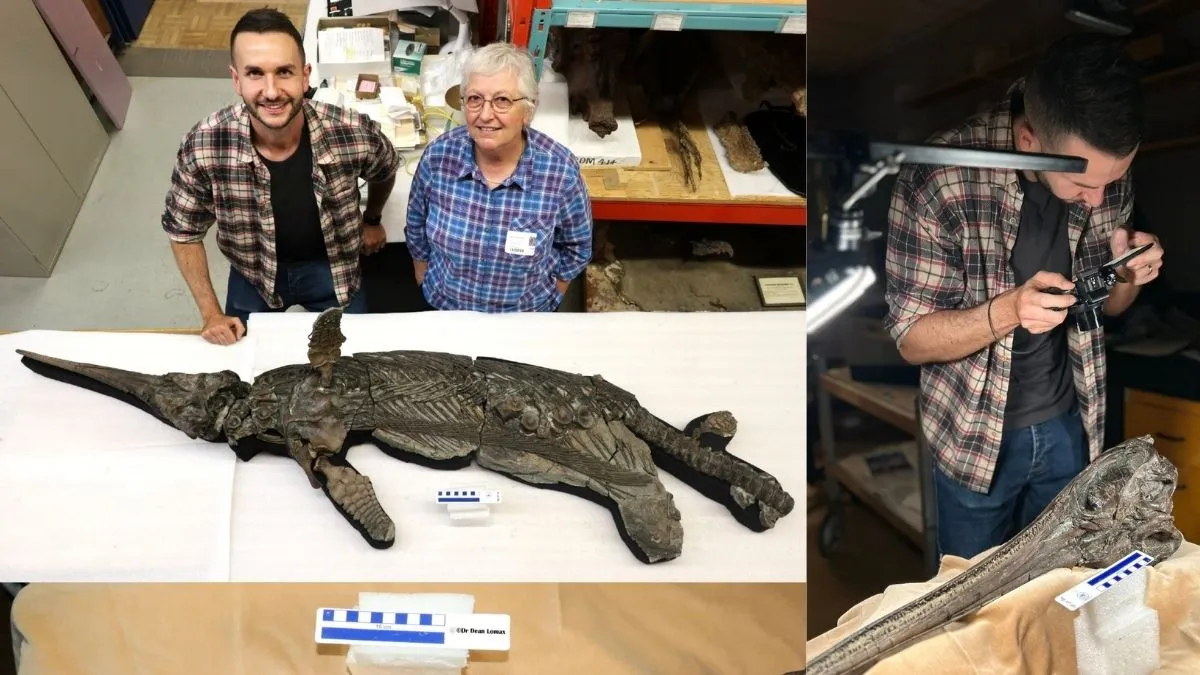- By Supratik Das
- Fri, 10 Oct 2025 07:53 PM (IST)
- Source:JND
A rare, exceptionally well-preserved fossil of a prehistoric sea reptile has been unearthed along Britain's Jurassic Coast, further illuminating the history of ichthyosaurs. The newly named species, Xiphodracon goldencapensis or the "Sword Dragon of Dorset," existed around 190 million years ago during the early Jurassic Pliensbachian stage.
The discovery, led by Dr. Dean Lomax of the University of Manchester, who is an expert in ichthyosaurs, is one of the most intact reptile fossils from the period ever discovered. The researchers opine that the fossil fills an essential missing link in the marine reptile evolutionary history and gives us a glimpse of the Jurassic seas' ecology.
Unique Fossil Discovery Details
• The fossil was initially discovered in 2001 off Golden Cap, Dorset, by collector Chris Moore.
• Differing from most ichthyosaur fossils, this skeleton had a complete three-dimensional form, enabling scientists to examine the anatomy in incredible detail.
• The fossil has a sword-like, elongated snout with hundreds of small needle-like teeth, and big eyes that imply a predatory diet.
• The skeleton is about three meters (9.8 feet) long, similar in size to a modern dolphin.
• It is preserved because of an anoxic seabed that prevented scavenging and decay, which preserved the skeleton for millions of years.
Dr. Lomax called the specimen "genuinely eye-catching," pointing out the unusually long snout and enormous eyes, as well as a special lacrimal bone close to the nostril, never noticed before in any other ichthyosaur. The fossil offers the rare chance of insight into the anatomy, habits, and ecological position of marine reptiles during a time of dramatic evolutionary and environmental transition.
Significance of The Discovery
The Dorset Sword Dragon also has a fascinating path to scientific acceptance. Following its discovery, the fossil was shipped to the Royal Ontario Museum, where it lay for the most part unresearched until Dr. Lomax began its analysis. A second specimen, which has been nicknamed "Gonzo" for the buckled jaw, is now housed at the Charmouth Heritage Coast Centre in Dorset. The original skeleton will be displayed at the Royal Ontario Museum in Toronto, Canada, where the public will get to see one of the best-preserved ichthyosaur fossils of this era.
The find is of great scientific importance. It completes a key evolutionary puzzle in the history of ichthyosaurs, provides information on early Jurassic marine predator-prey relationships, and enables scientists to investigate faunal turnover during a pivotal phase in the ecological record. In Chris Moore's opinion, the extended period of lag between discovery and formal description, though rare, "is nothing in geological time.
ALSO READ: Sharks Are Older Than Trees: Here Is How That Is Possible
The study has been published in the journal Papers in Palaeontology, offering scientists and enthusiasts a glimpse into the life of a rare sea reptile that dominated ancient Dorset seas.

